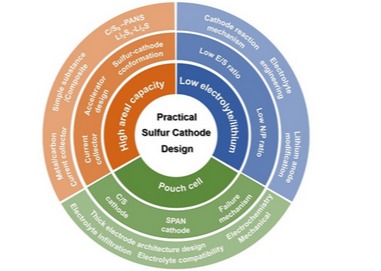《Challenges and Key Parameters in Exploring Cyclability Limitation of Practical Lithium Sulfur Batteries》
Lithium-sulfur batteries are the most promising candidates for the next generation of electricity storage technology because of their high energy density and low cost. However, practical lithium-sulfur batteries with high sulfur loads, low E/S and low N/P are severely hampered by some inherent defects, including the shuttle effect of polysulfide intermediates, short cycle life, and slow reaction kinetics. Here, we systematically summarized and analyzed the cyclic performance of lithium-sulfur batteries with an area capacity of more than 5 mAh cm-2, paying particular attention to the key parameters of high sulfur loads under low E/S ratio (E/S≤5µL mg−1) and low N/P ratio (N/P≤5), and indicated key strategies for optimizing electrochemical performance. Clarify the development roadmap, analyze related scientific challenges, standardize the electrochemical testing conditions of practical sulfur positive electrode, reveal the recyclable limit, and promote the industrialization process of lithium sulfur battery. This paper systematically summarizes the lithium sulfur battery which has good performance in practical application, and emphatically analyzes its failure mechanism. Therefore, this review not only gives the various electrochemical performance thresholds of the coin button battery and the soft pack battery, but also provides the possibility to promote the practical and commercial application of lithium sulfur battery in the near future.

https://pubs.rsc.org/en/content/articlelanding/2021/ta/d1ta06499a
